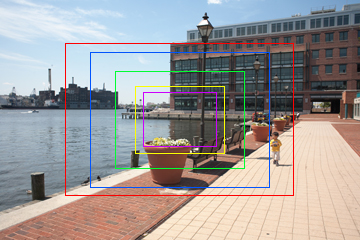Recently, Thom Hogan updated an article describing the sort of compact camera he wants. Many have also read of Mike Johnston's desire for a DMD. Thom believes that the technology is currently available to design a compact camera with a relatively fast (f/2.8-4) zoom and an APS-C sensor. I remain skeptical about this; however, thinking about these issues in camera design has me wondering again about my old friend, the bridge camera.
Before continuing, it would be helpful to review relative sensor sizes among currently available cameras. The following image demonstrates some common relative sensor sizes. Of course the actual sensors are smaller than depicted.
The entire image corresponds to the relative size of a "full frame" digital sensor such as the one in the Canon 5D. The red, blue, green, yellow, and purple lines correspond to the relative sizes of APS-C, 4/3", 1", 2/3", and 1/1.8" sensors respectively. The background image is there to illustrate the "crop factor," which is beyond the scope of my brief post here. The largest sensors in current, very compact cameras are around 1/1.7". Not too long ago, we had 2/3" sensors. Now, the next step up in sensor size from 1/1.7" (which would be between purple and yellow in the image above) is a huge leap to 4/3" (depicted above in blue). Comparing the smallest 4/3 system, the Olympus E-410 with kit lens, with DSLR systems based around the next step up in sensor size (APS-C) demonstrates the fact that smaller systems can be designed around smaller sensors. The, as of yet vaporware, Sigma DP1 promises a compact camera featuring an APS-C sensor. Likely this is possible in part since no mirror mechanism is incorporated, and in part because the DP1 features a prime lens of modest speed (f/4).
Why is there a leap from 1/1.7" to 4/3"? Surely a non-SLR digital camera with a 1" current-generation-technology sensor could be designed to be smaller than any DSLR + equivalent focal length range lens kit. Such a non-SLR camera would certainly provide better image quality and greater potential for shallow DOF than any current, smaller sensor compact digital cameras. The way I see it, these 1" sensor cameras could be made no larger than current "superzoom" cameras such as the Canon S5 IS or Olympus SP-550 by incorporating the tradeoff of a larger sensor and a more modest (2-3x) zoom range. Take, for example, my old Leica Digilux 2 (D2). The D2 could be made more compact today by 1) applying current generation design methods, and 2) making the lens non-fixed in length. The second of those two changes is not something I'd want, but it's worth mentioning that it could be done. In addition, one could presumably increase the D2 sensor size from 2/3" to 1" without increasing the overall size (largely determined by the lens size), if one were willing to accept a slower zoom, such as f/2.8-3.5 rather than f/2-2.4.
It makes no sense to me that we have only cameras with sensor sizes of 1/2.5", 1/1.8", 1/1.7", 4/3", 1.8" (APS-C), and 35mm. There is a large gap between 1/1.7" and 4/3" that is waiting to be plugged with 1" sensors. I am confident that bridge cameras derived from such sensors could be profitable in 2007 and beyond.



Good post. It'd be interesting to see a diagram of sensors side by side in proper ratio. I think that'd really drive the point in.
Thanks Jimmie. Look here for a good visual comparison of sensor sizes -> http://www.outbackphoto.com/dp_essentials/dp_essentials_01/essay.html